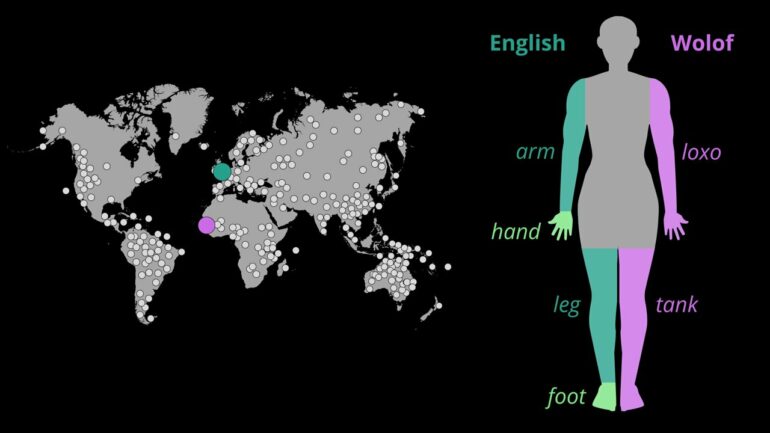Human bodies have similar designs. However, languages differ in the way they divide the body into parts and name them. For example, English speakers have two words for foot and leg, whereas other languages express the concepts foot and leg in one word.
The study of the variation in body part vocabularies across diverse languages has attracted the attention of researchers in linguistics, anthropology and psychology for many years. Similar to the principles developed for the semantic domain of color, universal tendencies have been identified and contrasted with culture-specific variations.
The emergence of new methods in network analysis has made it possible to conduct large-scale comparisons of vocabulary in specific semantic domains to study universal and cultural structures.
Professor Johann-Mattis List, who leads the chair of Multilingual Computational Linguistics at the University of Passau, is one of the researchers who developed algorithms in order to shed light on the question of how humans form their vocabulary in different languages.
He joined researchers from the Department of Linguistic and Cultural Evolution at the Max Planck Institute for Evolutionary Anthropology in Leipzig, in their study comparing the vocabulary of body parts in 1,028 languages.
The study, titled “Universal and cultural factors shape body part vocabularies,” has now been published in Scientific Reports.
Languages differ in how they name body parts
“Although our bodies follow similar designs, languages differ in how they divide the body into parts and name them,” says Annika Tjuka, a former doctoral student with Professor List and now postdoctoral researcher at MPI-EVA, who initiated and conducted the study.
“In English, we have one word for arm and another for hand, but Wolof, a language spoken in Senegal in West Africa, uses one word, loxo, to refer to both body parts. Speakers of both languages have a human body. So why do they differ in which parts are given unique names?”
The results confirm the principle that if a separate word exists for foot, then there will also be one for hand. But the results also show that a body part that is adjacent to another is more likely to have the same name. One reason for this pattern is that languages like Wolof focus on and emphasize the functional features that connect two parts.
Speakers recognize that we throw a ball with our hand and arm, or that we walk with our leg and foot. Languages like English, on the other hand, focus on visual cues like the wrist or ankle to separate parts.
Body part vocabularies vary from language to language. However, general tendencies emerge within this diversity. “To understand the factors that shape linguistic diversity, we need more data. We need to document the languages spoken in linguistically diverse areas. And we need to collect data on the sociological context in which the languages are spoken,” says Dr. Tjuka.
Large collection of wordlists across the world’s languages
For the current study, the team of linguists used an existing database, Lexibank, which is developed by researchers at the MPI-EVA in Leipzig and the Chair of Multilingual Computational Linguistics in Passau. It is a large collection of wordlists across the world’s languages.
With a computational approach, the Passau and Leipzig researchers extracted the words for 36 body parts in all these languages and analyzed the relationships between the words in a network analysis.
“It took us several years to assemble the data in the Lexibank collection,” says Professor List, who used to work as a senior researcher at the MPI-EVA in Leipzig. “Now we can start to analyze the data in various ways.”
Professor List heads the research group “ProduSemy” at the University of Passau. Together with his research team he also uses the data base in order to understand how word families are formed across languages.
More information:
Annika Tjuka et al, Universal and cultural factors shape body part vocabularies, Scientific Reports (2024). DOI: 10.1038/s41598-024-61140-0
Provided by
Universität Passau
Citation:
Researchers develop algorithms to understand how humans form body part vocabularies (2024, May 13)



